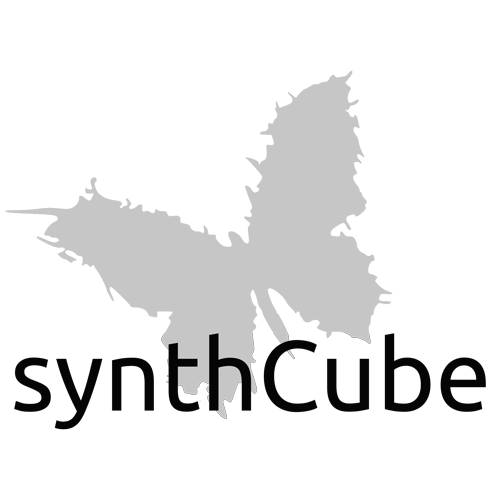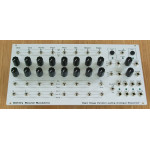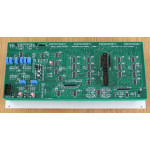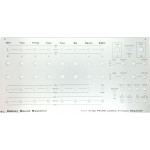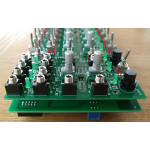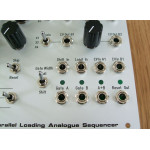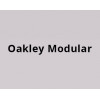Oakley Euro Sequencer
Oakley Euro Sequencer
Build documentation here: https://www.oakleysound.com/Sequencer%20Builder's%20Guide.pdf
User Guide here: https://www.oakleysound.com/Sequencer%20User%20Manual.pdf
Aluminum panel for eurorack based on Oakley Modular design
This is an SMT project- experience with DIY SMT is important for successful completion. We do not recommend this as a ‘first kit’ for DIY SMT!
The Oakley Sound Sequencer is a 50HP wide eurorack analogue sequencer with a maximum of eight steps and multistage loading capability. Each step can be selected to reset the sequence back to the start, or to skip and go straight to the next step without being engaged. Through a set of switches at the top of the module it is possible to load multiple stages so that more than one step at a time can be made active. In this way, the notes on each active step are added together to form a new control voltage.
The Sequencer is designed to be played as the sequence is running, new notes can be selected, steps can be changed to skip or reset, and the number of active steps can be altered on the fly. This hands on approach produces a real time controllable musical instrument that can create constantly changing sequences that belie the initial number of available steps.
Each step on the sequencer has two control voltage channels, A and B, each controlled by its own row of pots. Each channel has two outputs. One output has a fixed range determined by a three way toggle switch that can be set so that a single active step can be varied from either 0 to 1V, 0 to 2V, or 0 to 4V. The second output is fully variable and can be adjusted so that a single active step can be varied from 0V to a maximum of 9.5V. If multiple steps are selected than the output CV will increase linearly, so with two active steps producing 1V each, the final output will be 2V.
A reset output (+5V when active) will go high when the sequencer returns back to first active step. This can be used to trigger other modules such as a sequential switch which can allow both channels to be alternatively switched to allow sequences of up to 16 steps long.
The sequencer is advanced by use of the external shift input or the front panel's shift button. The external shift input can be any positive going signal above 1V. The sequencer can be shifted at very high speeds, over 20kHz, so it is possible to use the sequencer to generate audio waveforms and divide down effects. Some other sequencers use the word 'sync' or 'clock' to designate the shift function. An LED lights up whenever a shift command is active.
Each of the eight steps has a three way gate switch. This selects whether any active steps control one of two gate outputs. Each step can be set to trigger either Gate A, Gate B or neither. A third gate output goes high when either Gate A or Gate B is active. All gate outputs are +5V when active and 0V when off. A toggle switch selects whether the gate outputs are high whenever any selected step is active, or are only high when both the selected step and the shift command is active.
Multiple steps can be selected by the Oakley Sequencer's load function. Like the shift command, load can be instigated by either an external gate type signal or a push button. At the top of each step is a three way switch. On a load command, each switch can be set to force that stage to either, be switched on, be switched off, or left in whatever state it is already in. Traditional one step sequencing is simply obtained by having all switches in the off state bar the first one. Pressing load is then the equivalent of a simple reset. Through the 'load on shift' switch the load command can either be set to load the moment the load is activated, or to wait until the next shift command is received. The latter is very useful for keeping things in time with the master tempo clock. An LED lights once the load is activated and is waiting for the next shift command.
Current consumption is +85mA and -40mA at +/-12V.
The PCB set
The sequencer comprises of two circuit boards. The main board houses the digital circuitry, the power supply and reference circuits, and the analogue output circuitry. The pot and switch board has all the pots, switches and sockets that are attached to the front panel, as well as the LED drivers, the analogue pot drivers, and the CV summing circuitry. The main board is a four layer design, while the pot and switch board is a two layer design. Each board is the same size; 249 mm x 107 mm.
The majority of the components are surface mount parts. The ICs are SOIC, the resistors and capacitors are 0805, and the diodes are SOD123. All components are standard parts and this is a hardware only project - there is no firmware or microcontrollers to program.
Two 16 way IDC headers are provided on the main board for further expansion. One header carries the eight individual stage outputs, and the other has the eight set and clear inputs for the individual stages.
SOUND SAMPLE:
| Module Parameters | |
| Format | Eurorack |
| Panel Size | 50HP |
